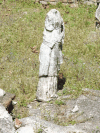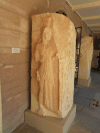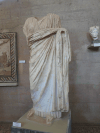
Sanctuary of Demeter, Dion, Greece. (1182k)
From the Demeter entry in Wikipedia:
In ancient Greek religion and mythology, Demeter is the Olympian goddess of the harvest and agriculture, presiding over crops, grains, food and the fertility of the earth. Although she is mostly known as a grain goddess, she also appeared as a goddess of health, birth, marriage, and had connections to the Underworld. She is also called Deo. In Greek tradition, Demeter is the second child of the Titans Rhea and Cronus, and sister to Hestia, Hera, Hades, Poseidon and Zeus. Like her other siblings but Zeus, she was swallowed by her father as an infant, and rescued by Zeus.
By her brother Zeus she became the mother of Persephone, a goddess of fertility.
Her cult titles include Sito, "she of the Grain", as the giver of food or grain, and Thesmophoros, "giver of customs" or "legislator", in association with the secret female-only festival called the Thesmophoria. Though Demeter is often described simply as the goddess of the harvest, she presided also over the sacred law, and the cycle of life and death. She and her daughter Persephone were the central figures of the Eleusinian Mysteries, a religious tradition that predated the Olympian pantheon, and which may have its roots in the Mycenaean period c. 1400–1200 BCE.
Demeter was often considered to be the same figure as the Anatolian goddess Cybele, and she was identified with the Roman goddess Ceres.
All pictures are © Dr. Günther Eichhorn, unless otherwise noted.
Goddess of the harvest, agriculture, fertility and sacred law.
She is a member of the Twelve Olympians.
Demeter was the second daughter and child of Cronus and Rhea. Like her sisters and two of her brothers, she was swallowed as a newborn by her father due to his fear of being overthrown by one of his children; she was freed when her youngest brother Zeus made Cronus disgorge all his children by giving him a special potion.
Demeter is notable as the mother of Persephone, described by both Hesiod and the Homeric Hymn to Demeter as the result of a union with her younger brother Zeus.
Demeter and Zeus were also the parents of Dionysus.
Demeter's daughter Persephone was abducted to the underworld by Hades, who received permission from her father Zeus to take her as his bride. Demeter searched for her ceaselessly for nine days, preoccupied with her grief. Hecate then approached her, and said to her that while she had not seen what happened to Persephone, she heard her screams. Together the two goddesses went to Helios, the sun god, who witnessed everything that happened on earth thanks to his lofty position. Helios then revealed to Demeter that Hades had snatched a screaming Persephone to make her his wife with the permission of Zeus, the girl's father. Demeter then filled with anger. The seasons halted; living things ceased their growth, then began to die. Faced with the extinction of all life on earth, Zeus sent his messenger Hermes to the underworld to bring Persephone back. Hades agreed to release her if she had eaten nothing while in his realm; but Persephone had eaten a small number of pomegranate seeds. This bound her to Hades and the underworld for certain months of every year, either the dry Mediterranean summer, when plant life is threatened by drought, or the autumn and winter. There are several variations on the basic myth; the earliest account, the Homeric Hymn to Demeter, relates that Persephone is secretly slipped a pomegranate seed by Hades and in Ovid's version, Persephone willingly and secretly eats the pomegranate seeds, thinking to deceive Hades, but is discovered and made to stay. Contrary to popular perception, Persephone's time in the underworld does not correspond with the unfruitful seasons of the ancient Greek calendar, nor her return to the upper world with springtime. Demeter's descent to retrieve Persephone from the underworld is connected to the Eleusinian Mysteries. Demeter rejoiced, for her daughter was by her side.
Demeter's search for her daughter Persephone took her to the palace of Celeus, the King of Eleusis in Attica. She assumed the form of an old woman, and asked him for shelter. He took her in, to nurse Demophon and Triptolemus, his sons by Metanira. To reward his kindness, she planned to make Demophon immortal; she secretly anointed the boy with ambrosia and laid him in the flames of the hearth, to gradually burn away his mortal self. But Metanira walked in, saw her son in the fire and screamed in fright. Demeter abandoned the attempt. Instead, she taught Triptolemus the secrets of agriculture, and he in turn taught them to any who wished to learn them. Thus, humanity learned how to plant, grow and harvest grain.
Homer's Odyssey (c. late 8th century BCE) contains perhaps the earliest direct references to the myth of Demeter and her consort Iasion, a Samothracian hero whose name may refer to bindweed, a small white flower that frequently grows in wheat fields. In the Odyssey, Calypso describes how Demeter, "without disguise", made love to Iasion. "So it was when Demeter of the braided tresses followed her heart and lay in love with Iasion in the triple-furrowed field; Zeus was aware of it soon enough and hurled the bright thunderbolt and killed him." However, Ovid states that Iasion lived up to old age as the husband of Demeter. In ancient Greek culture, part of the opening of each agricultural year involved the cutting of three furrows in the field to ensure its fertility.
In Arcadia, located in what is now southern Greece, the major goddess Despoina was considered the daughter of Demeter and Poseidon Hippios, Horse-Poseidon. In the associated myths, Poseidon represents the river spirit of the underworld, and he appears as a horse as often happens in northern European folklore. The myth describes how he pursued his older sister, Demeter, who hid from him among the horses of King Onkios, but even in the form of a mare, she could not conceal her divinity. In the form of a stallion, Poseidon caught and raped his older sister. Demeter was furious at Poseidon's assault; in this furious form, she became known as Demeter Erinys. Her anger at Poseidon drove her to dress all in black and retreat into a cave in order to purify herself, an act which was the cause of a universal famine. Demeter's absence caused the death of crops, of livestock, and eventually of the people who depended on them (later Arcadian tradition held that it was both her rage at Poseidon and her loss of her daughter that caused the famine, merging the two myths). Demeter washed away her anger in the River Ladon, becoming Demeter Lousia, the "bathed Demeter".
"In her alliance with Poseidon," Kerényi noted, "she was Earth, who bears plants and beasts, and could therefore assume the shape of an ear of grain or a mare." She bore a daughter Despoina (Δέσποινα: the "Mistress"), whose name should not be uttered outside the Arcadian Mysteries, and a horse named Arion, with a black mane and tail.
At Phigaleia, a xoanon (wood-carved statue) of Demeter was erected in a cave which, tradition held, was the cave into which Black Demeter retreated. The statue depicted a Medusa-like figure with a horse's head and snake-like hair, holding a dove and a dolphin, which probably represented her power over air and water:
Another myth involving Demeter's rage resulting in famine is that of Erysichthon, king of Thessaly. The myth tells of Erysichthon ordering all of the trees in one of Demeter's sacred groves to be cut down, as he wanted to build an extension of his palace and hold feasts there. One tree, a huge oak, was found to be covered with votive wreaths, symbols of the prayers Demeter had granted, and so Erysichthon's men refused to cut it down. The king used an ax to cut it down himself, killing a dryad nymph in the process. The nymph's dying words were a curse on Erysichthon. Demeter punished the king by calling upon Limos, the spirit of unrelenting and insatiable hunger, to enter his stomach. The more the king ate, the hungrier he became. Erysichthon sold all his possessions to buy food, but was still hungry. Finally, he sold his own daughter, Mestra, into slavery. Mestra was freed from slavery by her former lover, Poseidon, who gave her the gift of shape-shifting into any creature at will to escape her bonds. Erysichthon used her shape-shifting ability to sell her numerous times to make more money to feed himself, but no amount of food was enough. Eventually, Erysichthon ate himself.
In a variation, Erysichthon tore down a temple of Demeter wishing to build a roof for his house; she punished him the same way, and near the end of his life she sent a snake to plague him. Afterwards Demeter put him among the stars (the constellation Ophiuchus), as she did the snake, to continue to inflict its punishment on Erysichthon.
In the Pergamon Altar, which depicts the battle of the gods against the Giants (Gigantomachy), remains survive of what seems to have been Demeter fighting a Giant labeled "Erysichthon."
Once Tantalus, a son of Zeus, invited the gods over for dinner. Tantalus, wanting to test them, cut his son Pelops, cooked him and offered him as meal to them. They all saw through Tantalus' crime except Demeter, who ate Pelops' shoulder before the gods brought him back to life.
While she was traveling far and wide looking for her daughter, Demeter arrived exhausted in Attica. A woman named Misme took her in and offered her a cup of water with pennyroyal and barley groats in it, for it was a hot day. Demeter, in her thirst, swallowed the drink clumsily. Witnessing that, Misme's son Ascalabus laughed and mocked her and asked her if she would like a deep jar of that drink. Demeter then poured her drink over him and turned him into a gecko, hated by both men and gods. It was said that Demeter showed her favor to those who killed geckos.
Before Hades abducted her daughter, he had kept the nymph Minthe as his mistress. But after he married Persephone, he set Minthe aside. Minthe would often brag about being lovelier than Persephone, and saying Hades would soon come back to her and kick Persephone out of his halls. Demeter, hearing that, grew angry and trampled Minthe; from the earth then sprang a lovely-smelling herb named after the nymph. In other versions, Persephone herself is the one who kills and turns Minthe into a plant for sleeping with Hades.
In the Argive version of this myth, when Demeter arrived in Argolis, a man named Colontas refused to receive her in his house, whereas his daughter Chthonia disapproved of his actions. Colontas was punished by being burnt along with his house, while Demeter took Chthonia to Hermione, where she built a sanctuary for the goddess.
Demeter pinned Ascalaphus under a rock for reporting, as sole witness, to Hades that Persephone had consumed some pomegranate seeds. Later, after Heracles rolled the stone off Ascalaphus, Demeter turned him into a short-eared owl instead.
Demeter also turned the Sirens into half-bird monsters for not helping her daughter Persephone when she was abducted by Hades.
Once, the Colchian princess Medea ended a famine that plagued Corinth by making sacrifices to Demeter and the nymphs.
Demeter gave Triptolemus her serpent-drawn chariot and seed, and bade him scatter it across the earth (teach mankind the knowledge of agriculture). Triptolemus rode through Europe and Asia until he came to the land of Lyncus, a Scythian king. Lyncus pretended to offer what's accustomed of hospitality to him, but once Triptolemus fell asleep, he attacked him with a dagger, wanting to take credit of his work. Demeter then saved Triptolemus by turning Lyncus into a lynx, and ordered Triptolemus to return home air-borne. Hyginus records a very similar myth, in which Demeter saves Triptolemus from an evil king named Carnabon who additionally seized Triptolemus' chariot and killed one of the dragons, so he might not escape; Demeter restored the chariot to Triptolemus, substituted the dead dragon with another one, and punished Carnabon by putting him among the stars holding a dragon as if to kill it.
During her wanderings, Demeter came upon the town of Pheneus; to the Pheneates that receives her warmly and offered her shelter she gave all sorts of pulse, except for beans, deeming it impure. Two of the Pheneates, Trisaules and Damithales, had a temple of Demeter built for her. Demeter also gifted a fig tree to Phytalus, an Eleusinian man, for welcoming her in his home.
In the tale of Eros and Psyche, Demeter along with her sister Hera visited Aphrodite, raging with fury about the girl who had married her son. Aphrodite asked the two of them to search for her; the two of them try to talk sense into her, arguing that her son is not a little boy, although he might appear as one, and there's no harm in him falling in love with Psyche. Aphrodite took offense at their words. Sometime later, Psyche in her wanderings came across an abandoned shrine of Demeter, and sorted out the neglected sickles and harvest implements she found there. As she was doing so, Demeter appeared to her, and called from afar; she warned the girl of Aphrodite's great wrath and her plan to take revenge on her. Then Psyche begged the goddess to help her, but Demeter answered that she could not interfere and incur Aphrodite's anger at her; and for that reason Psyche had to leave the shrine, or else be kept as a captive of hers.
When her son Philomelus invented the plow and used it to cultivate the fields, Demeter was so impressed by his good work she immortalized him in the sky by turning him into a constellation, the Boötes.
Hierax, a man of justice and distinction, set up sanctuaries to Demeter and received plenteous harvests from her in return. He neglected Poseidon in favor of Demeter, so the sea-god destroyed all of her crops.
Besides giving gifts to those who were welcoming to her, Demeter was also a goddess who nursed the young; all of Plemaeus's children born by his first wife died in cradle; Demeter took pity of him and reared herself his son Orthopolis. Plemaeus built a temple to her to thank her. Demeter also raised Trophonius, the prophetic son of either Apollo or Erginus.




This page contains 4 pictures
Here are the links to the other main pages on Greece:
Page last updated on Fri Aug 19 17:48:25 2022 (Mountain Standard Time)